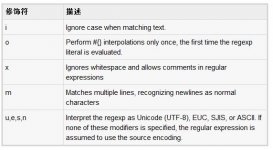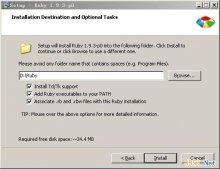让我们写一个简单的ruby程序。所有Ruby源文件将以扩展名.rb。因此,把下面的源代码在一个test.rb文件。
1 2 3 | #!/usr/bin/ruby -wputs "Hello, Ruby!"; |
在这里,假定您已经安装有Ruby解释器,可以在/usr/bin目录找到。现在尝试运行此程序如下:
1 | $ ruby test.rb |
这将产生以下结果:
1 | Hello, Ruby! |
通过以上实例,我们已经看到了一个简单的Ruby程序,现在让我们来看看有关Ruby语法的几个基本概念:
Ruby程序中的空白符:
在Ruby代码一般都忽略空白字符,例如空格和制表符,除非当它们出现在字符串中。但是,有时它们被使用解释模棱两可的报表。诠释这种类型-w选项启用时产生警告。
实例:
1 2 | a + b is interpreted as a+b ( Here a is a local variable)a +b is interpreted as a(+b) ( Here a is a method call) |
Ruby程序行结尾:
Ruby解释一个语句中以分号和换行符表示结束。但是,如果Ruby遇到运算符,如+,- 或反斜杠结尾的行,则表示语句继续。
Ruby标识符:
标识符是变量,常量及方法。 Ruby的标识符是区分大小写的。Ram和RAM在Ruby中是两个不同意思的标识符。
Ruby的标识符名称可以由字母数字字符和下划线( _ ).
保留字:
下面的列表显示了Ruby的中的保留字。这些保留字不能用作常数或变量名。然而,它们可以被用作方法名。

Ruby中heredoc:
"Here Document" 是指建立多行字符串。继<<可以指定一个字符串或者一个标识符来终止字符串字面,当前行之后的所有行的终止符字符串的值。
如果终止符是引用,引号的类型决定面向行的字符串常量的类型。注意<<终止符之间不能有空格。
下面是不同的例子:
1 2 3 4 5 6 7 8 9 10 11 12 13 14 15 16 17 18 19 20 21 22 | #!/usr/bin/ruby -wprint <<EOF This is the first way of creating here document ie. multiple line string.EOFprint <<"EOF"; # same as above This is the second way of creating here document ie. multiple line string.EOFprint <<`EOC` # execute commands echo hi there echo lo thereEOCprint <<"foo", <<"bar" # you can stack them I said foo.foo I said bar.bar |
这将产生以下结果:
1 2 3 4 5 6 7 8 | This is the first way of creating her document ie. multiple line string. This is the second way of creating her document ie. multiple line string.hi therelo there I said foo. I said bar. |
Ruby BEGIN 语句
语法:
1 2 3 | BEGIN { code} |
声明代码在程序运行之前被调用。
例子:
1 2 3 4 5 6 7 | #!/usr/bin/rubyputs "This is main Ruby Program"BEGIN { puts "Initializing Ruby Program"} |
这将产生以下结果:
1 2 | Initializing Ruby ProgramThis is main Ruby Program |
Ruby END 语句
语法:
1 2 3 | END { code} |
声明代码被称为程序的结束。
语法:
1 2 3 4 5 6 7 8 9 10 | #!/usr/bin/rubyputs "This is main Ruby Program"END { puts "Terminating Ruby Program"}BEGIN { puts "Initializing Ruby Program"} |
这将产生以下结果:
1 2 3 | Initializing Ruby ProgramThis is main Ruby ProgramTerminating Ruby Program |
Ruby 注释:
注释隐藏一行,某一行的一部分或几行Ruby解释器忽略解释程序代码。可以使用的的哈希字符(#)开头的一行:
# I am a comment. Just ignore me.
或者,注释可能是在同一行后一个语句或表达式:
name = "Madisetti" # This is again comment
可以注释掉多行如下:
1 2 3 4 | # This is a comment.# This is a comment, too.# This is a comment, too.# I said that already. |
这里是另一种形式。此块注释隐藏几行注释: =begin/=end:
1 2 3 4 5 6 | =beginThis is a comment.This is a comment, too.This is a comment, too.I said that already.=end |




